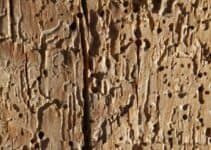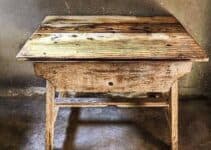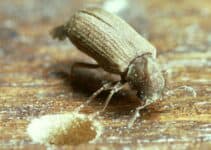Woodworm is a common problem that can affect antiques and vintage furniture for many homeowners in the UK. It can be a big hassle to deal with, especially if this is the first time you have had to deal with it. The woodworm can cause extensive damage to your home’s external and internal structures. In some cases, it could mean the destruction of your home.
The presence of woodworms in the home is not desirable. Besides destroying antique furniture like a piano, it can also make it unsightly, and worst of all, it can be hazardous.
However, if you have woodworm in antique furniture, you can successfully treat it. Read on to find out how.
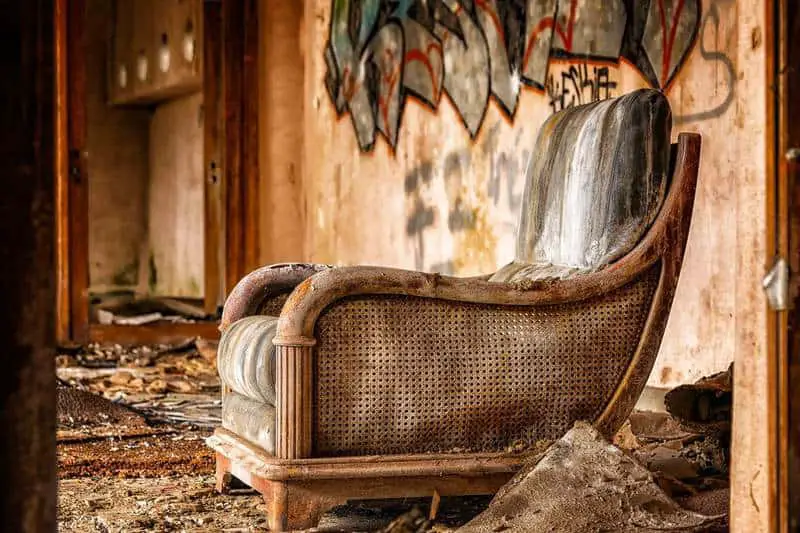
How Do You Get Rid Of Woodworm In Old Furniture?
You may find yourself with a woodworm infestation if you have antique wooden furniture. However, there is no need to get too worried. There are a few things you can do to make sure you can get rid of woodworm in old furniture.
The first thing you need to do is identify the woodworm species that affect your furniture. There are a few different types, and each requires another woodworm treatment method.
The most common type of woodworm is the Common Furniture Beetle. This type of woodworm is found in most homes in the UK.
The next step is to figure out the severity of the woodworm infestation. This will help you determine the best course of action.
If the woodworm is only affecting a small area of your furniture, you may be able to treat it yourself, you can consider freezing it or use vinegar:
However, if the infestation is more severe, you may need to call in a professional.
There are a few different ways to get rid of woodworm in old furniture. Here is how to treat old furniture:
Inspect the Furniture
The first step is to inspect the furniture for active woodworm damage. Look for small holes in the wood and sawdust around the holes. If you see any damage, it’s vital to take action to get rid of the woodworm.
Clean the Furniture
Once you’ve identified the damaged areas, it’s time to clean the furniture. Use a vacuum cleaner to remove any dust or sawdust from the holes. You can also use a damp cloth or steam to clean the furniture’s surface.
Apply Woodworm Killer
The next step is to apply a woodworm killer to the affected areas. There are a variety of woodworm killers available on the market. Be sure to follow the instructions on the package when applying the killer.
This is my go to for woodworm killer you can use at home. It’s clear so won’t leave any stain on your antique furniture:
Wait for the Furniture to Dry
Once you’ve applied the woodworm killer, it’s important to wait for the furniture to dry. It can take a few days for the furniture to dry completely, so be patient.
Check the Furniture for Signs of Damage
Once the furniture has dried, it’s important to check for any signs of further damage. If you notice any new holes or sawdust, likely, the woodworm is still present. In this case, you’ll need to repeat the treatment process until the woodworm is gone.
Remember to wear gloves and a mask when spraying insecticides, and ensure that all members of your household are safe from contact with treated surfaces. It’s also important to keep children and dogs away from treated areas until dry.
Can Furniture With Woodworm Be Saved?
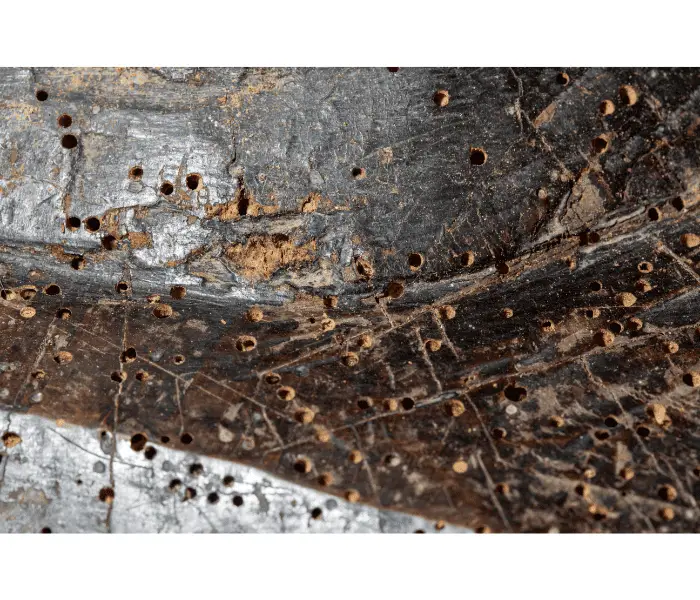
It depends on the severity of the woodworm damage. If the damage is extensive, it may not be possible to save the furniture. However, if the damage is limited to a few areas, it may be possible to repair the furniture, small items like picture frames are easier to save.
It is difficult to assess whether any particular piece of furniture will be salvageable unless you are a specialist in furniture conservation techniques.
Some beetle infestations will only affect the surface layer of timber and so can often be treated without damage to the structure or decorative finish. Other times, a larger area will need to be cut out and replaced using traditional joints and matching timber – this is where an experienced furniture conservator will be able to advise you.
Some woodworm can cause extensive damage to the timber, eating through several layers, and in these cases, it may not be possible to save the piece of furniture.
If you have any doubts about whether you can save your furniture, it’s always best to consult a professional.
If the damage is limited to a few areas, you can save your furniture. However, you need to do it quickly and correctly to avoid any further damage. The treatment involves injecting a chemical such as permethrin into the wood.
I like this permethrin:
This will kill all woodworm larvae and adult beetles. Once this has been done, your furniture is safe to use again.
However, if the wood is extensively damaged, it may not be possible to save it. This can happen if the furniture is left untreated for an extended period.
How Can You Tell If Old Furniture Has Woodworm?
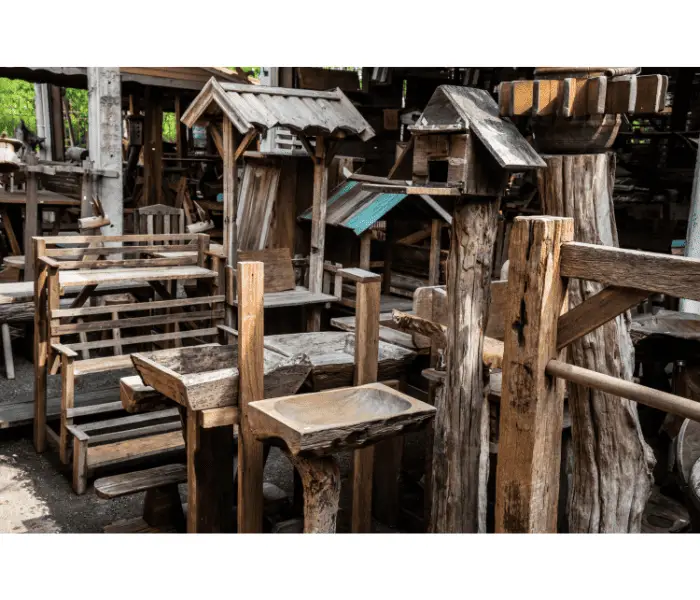
If you want to buy antiques and antique furniture, it’s important to know how to spot woodworm. There are several indicators that your furniture may be affected by woodworm.
A tell-tale sign of an infestation is the presence of tiny holes in wood caused by woodworm beetles. The holes left by woodworm are usually round, smooth, and range in size from 1mm to 1cm.
They can be found across the surface of the wood but are most likely to be seen towards the bottom of chairs, tables, and other furniture items.
If you see what appear to be holes in your furniture, before assuming they’re caused by woodworm, check if they’re actually knotholes or cracks in the grain – these can sometimes look similar.
Examine the furniture for signs of recent infestation, such as fresh frass or holes. These will be darker than others. If you’re not sure if your furniture has been infested, you can always ask for expert advice from auction houses or professional restorers who will be able to tell you whether the piece needs treatment.
If there is no visible evidence, but you’re still worried about buying a piece with previous problems, you can get the timber tested for infestation using ultra-violet light (UV). UV lamps are available to buy online here:
Another sign of woodworm is powdery dust known as frass that gathers near the holes and is sometimes visible around them. This happens when emerging beetles push their way out of infested timber and leave behind their waste material.
Frass is a good indicator that your furniture has been affected by woodworm because it’s not always easy to spot the beetles themselves – especially if there’s only a small colony present.
Also, if you tap the wood and it sounds hollow, this may be another sign of a problem. Hollow-sounding wood is often an indication of extensive damage caused by woodworm.
Can New Furniture Have Woodworm?
When buying new furniture, you want to know that your investment will stand the test of time. You’re looking for a quality piece of furniture which should be free from woodworm. So, can new furniture have woodworm?
It’s unlikely, but not impossible. If the wood used to make your furniture has been infested with woodworm, the problem might not be immediately apparent. The beetles could be in the early stages of their life cycle and not yet causing any damage.
It’s always best to check for signs of woodworm before you buy new furniture. If you’re concerned about the possibility of infestation, you can ask the seller for reassurance that the furniture is clean and free from woodworm.
You should also be aware that some types of wood are more susceptible to woodworm than others. Softwoods, such as pine, are particularly vulnerable because the wood is easier for the beetles to bore into. Hardwoods, such as oak and beech, are more resistant to woodworm but can still be affected.
When buying new furniture made from softwood, it’s important to check that it has been treated to prevent woodworm infestation. This treatment usually involves chemicals, such as insecticides, which kill or repel woodworm beetles.
Varnish or paint can also provide a barrier against woodworm, but it’s important to ensure that the surface is in good condition and free from cracks or chips.
Ask the seller or manufacturer for advice if you’re not sure whether your new furniture is protected against woodworm.
How Does Woodworm Get Into Furniture?
Woodworm is usually introduced into furniture through small cracks or holes in the wood. The beetles can also enter through gaps around doors and windows.
Once inside, the beetles lay their eggs on the surface of the wood. The eggs hatch into larvae which bore into the wood, feeding on it as they grow. The larvae then pupate and emerge as adult beetles, completing the life cycle.
Larvae can live in furniture for many years and but only emerge at certain times of the year, so even if you have bought a wooden table or chair made from freshly cut timber, it can still have larvae residing inside it.
Conditions That Encourage Woodworm
The conditions in your property will determine how likely you are to develop a woodworm problem. Some common situations can make your property more favourable for infestation. These include:
Damp
Woodworm love damp timber, as it is softer and easier to eat. In addition, dampness provides the perfect environment for the beetle eggs to thrive once they have been laid by the female. If you have damp problems on your property, you should deal with these before treating woodworm in furniture.
Poorly Ventilated Areas
Areas such as cellars and lofts are usually poorly ventilated and, therefore, more susceptible to woodworm infestations because they do not dry out quickly after being exposed to moisture.
Wet Timber
If you have wet timber on your property, this will also encourage woodworm infestation and spreading. Damp timber can be a problem if there is a leak in your roof or if the walls are wet.
Treating Woodworm with WD40
Treating woodworm with WD-40 involves the following steps:
- Identify the affected areas: Look for small round holes and fine sawdust.
- Shake the WD-40 can before use for a homogenous spray.
- Directly apply the WD-40: Spray liberally onto the affected areas.
- Let it soak: The solvent penetrates into the wood, killing the larvae.
- Repeat: Reapply as necessary.
Remember, WD-40 offers a temporary solution and won’t prevent re-infestation. It’s not a substitute for professional pest control services. Use it in well-ventilated areas and avoid open flames as it’s flammable.
Does WD40 Kill Woodworm?
WD40 is a popular product that is often used for various household tasks, including lubricating door hinges and cleaning greasy stains. But does WD40 kill woodworm?
WD40 is a strong solvent that can dissolve the protective wax coating that the female beetle lays over her eggs. This will kill the eggs and prevent them from hatching. WD40 can also kill woodworm larvae.
However, WD40 is not a long-term solution to woodworm infestation. It will only kill the beetles present at the time of woodworm treatment and will not prevent new eggs from being laid.
In addition, WD40 is not effective against all types of woodworm. The product is most effective against the common furniture beetle, the most common type of woodworm found in homes in the UK.
If you have a woodworm problem, it’s important to treat the infested timber with a suitable insecticide. This will kill the woodworm larvae and stop them from causing further damage.
FAQs
Can Woodworm In Furniture Be Treated?
Yes, woodworm in furniture can be treated using a range of different methods. These include the use of insecticides, varnish or paint.
How Do You Fix Woodworm Holes In Furniture?
If you have woodworm holes in your furniture, you can fix them by filling them with a suitable wood filler. Once the filler has dried, you can sand it down and repaint or varnish the surface.
How Do You Prevent Woodworm In Furniture?
The best way to prevent woodworm in furniture is to ensure that the surface is in good condition and free from cracks or chips. You should also avoid storing furniture in damp or poorly ventilated areas.
Can You Paint Over Woodworm?
Yes, you can paint over woodworm. This will seal the surface of the wood and prevent the beetles from being able to lay their eggs.
Woodworm in Furniture
It is essential to treat woodworm in furniture as soon as you notice the problem. If left untreated, the larvae can live in the wood for many years, causing significant damage.
Antique furniture is especially susceptible to woodworm damage as the wood is often damp and poorly ventilated. Ensure that your furniture is treated with a suitable insecticide to kill the larvae and stop them from causing further damage.





